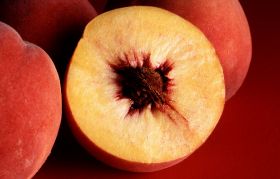Peaches
Volunteers who drank beverage sweetened with glucose in US experiment went on to consume more biscuits and sweets than people who didn’t
Fructose may increase cravings for high-calorie foods, according to a new study.
Researchers at the University of Southern California got 24 volunteers to consume a sugary drink sweetened with fructose – the sugar found in fruit – on one day and glucose on another day.

Compared with glucose, the fructose drink led to more hunger and desire for treats such as biscuits and sweets, suggesting that different sugars may affect us differently.
The participants were given a sweetened, cherry-flavoured drink but were not told what was in it – fructose or glucose.
Shortly afterwards, they were asked to rate how hungry they were. They then underwent brain scans while being shown pictures of foods such as biscuits, sweets, burgers and pizza, as well as some ‘neutral’ photographs of buildings.
Some days later, the same volunteers came in again and repeated the experiment. The only difference was the type of sweetener added to their cherry drink.
The brain scans showed that people responded more strongly to photos of food if they had been drinking fructose, rather than glucose. Some of the subjects also reported more food cravings for treats shortly after consuming fructose.
Although fructose and glucose contain the same energy or calories, the body breaks the sugars down in different ways, and the researchers believe this might explain their findings.
‘Exceptional’ peaches buck the trend for declining export volumes in South African stonefruit with UK market as top destination
The UK has overtaken the Middle East as the largest export market for South African peaches for the first time.

The country’s total peach exports jumped by 14% for the 2013 season, up from 1,197,427 tonnes in 2011/2012 to 1,382,637t for 2012/2013.
Product manager for South African producer group, Hortgro, Jacques du Preez, said peaches had an “exceptional season”. “Cultivars which performed well are Temptation and Transvalia, Ambercrest with an increase in export volumes of 145%, 31% and 45% respectively,” he added.
The UK was also the largest export market for the country’s nectarines, and is the second largest destination for plums.
Du Preez said: “Nectarines exports to the UK were on par with the previous season, peaches up and plums down. But it should be kept in mind that record export volumes materialised during 2012/2013, and that climatic conditions were extremely challenging this season.”
Apricot exports fell by 13%, nectarines saw a drop of five per cent while plums shrank by 7%, according to a Hortgro export report for 2012/2013. Total stonefruit exports fell by 6%, although the average crop was realised at 16,943,133t.
Many South African fruit crops were devastated following severe hailstorms in November 2013, and du Preez said that while an average crop had been achieved, adverse weather has affected fruit quality.
“Plum and nectarine orchards in the Ceres and Klein Karoo regions were mainly affected by the hail,” he said. “Prolonged spring conditions and rain during the harvest season influenced the quality and volumes of the crop.”
He added that reasonable increases in export volumes for the 2014/2015 season can be expected as around a third of stonefruit orchards are not yet in full bearing.
Du Preez said a campaign promoting South African fruit – named ‘Beautiful Fruit Beautiful Country’ – has so far been very Eurocentric, but in future this will expand its focus to Asia and Africa.
He said: “A strategy is being setup to get a much closer relationship between market access and market development. These two will work hand in hand to ensure the opening up of and expanding of markets – firstly in the ME, FE and Africa, but also in other regions of Europe we haven’t been active in.”